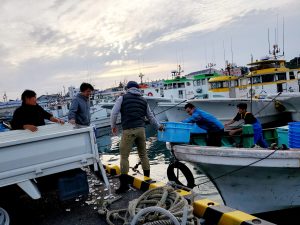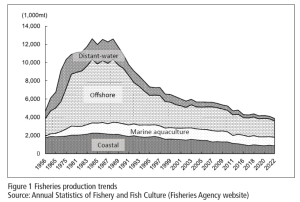The Japanese tenure rights system is primarily responsible for the sustainability of small-scale fisheries
This article is by Yinji Li (riginki@tokai.ac.jp), Associate Professor, School of Marine Science and Technology, Tokai University and Coordinator, TBTI Japan Research Network, Japan
The TBTI Global Book Series, Life Above Water (Jentoft 2019), has resonated with the public and received a great response in Japan. In a remarkable display of collaboration, dozens of researchers, government officials, and fishers have worked together to publish its translation. That may be because the country is currently “in the midst of a debate on whether voluntary/community-based management or quota-based management, small-scale/family operation or large-scale/corporate operation, fairness or efficiency, cooperation principle or competition principle, under the new Fisheries Act (2020), which has transformed the former coordination-oriented law into the resource management-oriented law after its first major revision in 70 years.”
This book emphatically argues that protecting life above water, that is, fishing people and communities engaged in small-scale fisheries (SSF) to protect life below water (SDG14), is essential; it provides an important perspective and stimulus for the path Japanese fisheries ought to take today. It is no exaggeration to say that the Japanese fishery, till today, has been the living proof of what is being argued in Life Above Water; this must be reaffirmed in the changing era.
Old values, Difference Principle
‘Iso-Wa-Ji-Tsuki, Oki-Wa-Iri-Ai (the local fishing community manages the inshore area, while the offshore area is open to everyone),’ This old saying encapsulates the local fishing community’s management of the inshore area, while the offshore area remains open to everyone. This saying also gives a window into the historical background of Japan’s tenure rights system for small-scale fisheries, a system deeply rooted in the Edo period (1603–1867).
The fishery rights system also plays a vital role in maintaining fisheries resources, contributing significantly to the sustainable production of coastal and small-scale fisheries
This was a time when conventional relations concerning coastal use were established based on each territory of the domain head. As a general principle, coastal communities were granted the rights to have exclusive access to their bordering waters, while the outer offing of rocky shores was open to fishers in nearby communities.
In 1875, a new system was introduced, requiring fishers to apply and pay fees for using a marine area. These sudden institutional changes led to chaos, prompting a legislative revision to revert to the previous customs. Since then, the existing structure of fishery rights has remained unchanged, upheld by the first Fisheries Act of 1901, its subsequent revisions, and the Fisheries Act of 1949.
As such, the small-scale fishers and fisheries cooperatives in Japan have been entitled to fishery rights comparable to real rights, recognizing their subjective rights and rights to life in a vulnerable position compared to industries with huge capital. This could be considered under John Rawls’s Difference Principle that claims that social and economic inequalities are to be arranged so that they are to the greatest benefit of the least advantaged; this principle that is enshrined in the FAO’s SSF Guidelines.

Meaning of the tenure rights
The Japanese tenure rights system is primarily responsible for the sustainability of small-scale fisheries and fishing communities and maintaining their traditions and cultures. The first role of the fishery rights system is to maintain the fishery order and stabilize the fishing communities based on it. The Fishery Act, which prescribes the rights to fisheries, is primarily a regulatory law governing fishing activities and the use of fishing grounds. In that sense, this is also the primary role of the fishery rights system.
Today, the use of fishing grounds is mostly disciplined, except for pending disputes in some areas. Also, the fishery rights system protects fishers’ lives. That is, the system ensures the fundamental viability of fishers’ livelihoods by granting them the exclusive right to use fishing grounds. It secures social justice by providing eligibility and priority for obtaining the right to fish. Therefore, fishery rights are established only through the governors of prefectures and are not obtainable through prescription, preemption, or custom. In particular, the common fishery rights have a general character that everyone in the community can use together. In choosing whether to pursue the efficiency of fishery production or the impartiality of the local community, Japan’s fishery rights system, especially the co-operative-managed fishery rights system, clearly pursues the latter.
The fishery rights system also plays a vital role in maintaining fisheries resources, contributing significantly to the sustainable production of coastal and small-scale fisheries (see Figure 1). Trends in data have shown that the coastal fishery’s production levels have remained relatively stable, while those of the offshore and distant water fisheries have shrunk. Specifically, the fishery rights system has severely restricted the entry of external capital and individuals into coastal fisheries. Historically, private investment in fisheries was policy-guided towards the offshore and distant water fisheries sector.
The other point is that fishery rights facilitate the functioning of voluntary fisheries management by fishers. As is well known, the ‘shigen-kanri-gata-gyogyo’ (resource management-oriented fisheries) principle has been promoted in Japanese policies since the mid-1980s. The experience has been attracting attention from the world as a form of community-based management. The fisheries rights system provides institutional conditions that facilitate the organizational functioning of the fisheries resource management bodies that take such approaches.
It is doubtful whether these fishers and fishing organizations can continue the tradition of self-governance, given that the new Fisheries Act partially ended the priorities when granting fishery rights (see Table 1). The fishery rights are classified into three types: set-net fishery rights, demarcated fishery rights, and common fishery rights. Among the types of fishery rights, the common fishery rights fisheries are mainly aimed at shellfish and algae. The eligibility for the rights is granted only to fisheries co-operatives, where a vast majority of local fishers are members.
 Such fisheries are generally run by individual fishers and require co-ordination among fishers regarding fishing grounds. Small-scale aquaculture by specific demarcated fishery rights (for example in oysters and seaweed) are operated similarly. Because of the ease of entry in terms of technology and necessary capital, the co-ordination between fishers becomes very important; therefore, the fishery co-operative is first in line.
Such fisheries are generally run by individual fishers and require co-ordination among fishers regarding fishing grounds. Small-scale aquaculture by specific demarcated fishery rights (for example in oysters and seaweed) are operated similarly. Because of the ease of entry in terms of technology and necessary capital, the co-ordination between fishers becomes very important; therefore, the fishery co-operative is first in line.
The rights can be granted to individuals, comparatively speaking, for demarcated fishery rights and set-net fishery rights, because there is a need for high technology and significant capital. For the former, those with experience in fisheries, including local fishers, have priority; for the latter, fisheries co-operatives and juridical persons with more local fishers are given priority.
The new Fishery Act abolished such an order of priority (see Table 1) and enabled private companies to enter aquaculture and set-net fisheries. The government will evaluate whether the fishing waters are being used ‘appropriately and effectively’. Although the guidelines regarding criteria for such evaluations are forthcoming, the self governance applied at the community level based on conventional fishery rights is believed to require revision to a greater or lesser extent due to the impact of the new Fishery Act.
 Terms like ‘deterioration of resources’, ‘decline of industry’, ‘the disappearance of fish from the table’, and ‘the end of Japan as a fishery nation’ have all led to the formation of a dark image of Japanese fisheries. Such gloom fosters a sense of crisis and raises questions about the governance system. Under such circumstances, there has been a strong appeal for the need to grow the industry further and to manage resources more scientifically, which has led to the recent revision of the Fisheries Act of 2020.
Terms like ‘deterioration of resources’, ‘decline of industry’, ‘the disappearance of fish from the table’, and ‘the end of Japan as a fishery nation’ have all led to the formation of a dark image of Japanese fisheries. Such gloom fosters a sense of crisis and raises questions about the governance system. Under such circumstances, there has been a strong appeal for the need to grow the industry further and to manage resources more scientifically, which has led to the recent revision of the Fisheries Act of 2020.
As a countermeasure for the former, ‘seicho-sangyoka’ (economic growth-centred industrialization) centred on the promotion of aquaculture and the ‘opening’ of fishery rights to private companies for that purpose has been introduced. For the latter, scientific resource management centred on the expansion of the quota system has been introduced and implemented; however, various confusions are occurring. Small-scale fisheries and fishing communities are scattered throughout Japan. Concurrently, small-scale fisheries and communities form the landscape and identity of the Japanese coast.
Can seicho-sangyoka-oriented policies ensure sustainable fisheries? What should be a real growth industry? The seicho-sangyoka or the Blue Economy or Blue Growth and other such initiatives are not necessarily negative to small-scale fisheries. It is also expected that new opportunities for small-scale fisheries will be created, which would not have been possible before.
Success, however, will only be realized when the ‘Difference Principle’ is respected. When the SSF Guidelines are fully recognized and implemented with a conscious effort. Echoing the need to secure a just space for small-scale fisheries in the Blue Economy, a just space for small-scale fisheries in seicho-sangyoka must be secured in Japan. Securing the tenure rights system is the way.
For more
This article is an adaptation of articles published in Li, Y & Namikawa, T. (2020) In the Era of Big Change: Essays about Japanese Small-Scale Fisheries. TBTI Global Publication Series, St. John’s, NL, Canada. (Chapter 1, Chapter 32, Chapter 47)
Adopting a Blue Justice Lens for Japanese Small-Scale Fisheries: Important Insights from the Case of the Inatori Kinme Fishery
https://www.springerprofessional.de/en/adopting-a-blue-justice-lens-for-japanese-small-scale-fisheries-/20198634
Securing a Just Space for Small-Scale Fisheries in the Blue Economy
https://www.frontiersin.org/articles/10.3389/fmars.2019.00171/full